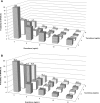Association of Clinical Events With Everolimus Exposure in Kidney Transplant Patients Receiving Low Doses of Tacrolimus
- PMID: 28141897
- PMCID: PMC5600116
- DOI: 10.1111/ajt.14215
Association of Clinical Events With Everolimus Exposure in Kidney Transplant Patients Receiving Low Doses of Tacrolimus
Abstract
A key objective in the use of immunosuppression after kidney transplantation is to attain the optimal balance between efficacy and safety. In a phase 3b, multicenter, randomized, open-label, noninferiority study, the incidences of clinical events, renal dysfunction, and adverse events (AEs) were analyzed at 12 months in 309 de novo renal transplant recipients receiving everolimus (EVR), low-dose tacrolimus (LTac), and prednisone. Cox proportional hazard regression modeling was used to estimate the probability of clinical events at specified combinations of time-normalized EVR and Tac trough concentrations. At 12 months, the highest incidence of treated biopsy-proven acute rejection (tBPAR) and graft loss occurred most often in patients with EVR trough concentration <3 ng/mL (64.7% and 10.5%, respectively). At 1 month and 12 months, increasing EVR levels were associated with fewer tBPAR events (both p < 0.0001). Low estimated glomerular filtration rate (eGFR) and decreased eGFR occurred more often in patients with lower EVR and higher Tac levels. AEs were most often observed in patients with EVR levels <3 ng/mL. This study supports maintaining an EVR trough concentration of 3-8 ng/mL, when combined with LTac, to achieve balanced efficacy and safety in renal transplant recipients.
Trial registration: NCT01025817.
Keywords: calcineurin inhibitor: tacrolimus; clinical research/practice; immunosuppressant; immunosuppressive regimens; kidney transplantation/nephrology; mechanistic target of rapamycin (mTOR); mechanistic target of rapamycin: everolimus; minimization/withdrawal.
© 2017 The Authors. American Journal of Transplantation published by Wiley Periodicals, Inc. on behalf of American Society of Transplant Surgeons.
Figures


References
-
- Moes DJ, Guchelaar HJ, de Fijter JW. Sirolimus and everolimus in kidney transplantation. Drug Discov Today 2015; 20: 1243–1249. - PubMed
-
- Nankivell BJ, Borrows RJ, Fung CL, O'Connell PJ, Chapman JR, Allen RD. Calcineurin inhibitor nephrotoxicity: Longitudinal assessment by protocol histology. Transplantation 2004; 78: 557–565. - PubMed
-
- Albano L, Berthoux F, Moal MC, et al. Incidence of delayed graft function and wound healing complications after deceased‐donor kidney transplantation is not affected by de novo everolimus. Transplantation 2009; 88: 69–76. - PubMed
-
- Chan L, Greenstein S, Hardy MA, et al. Multicenter, randomized study of the use of everolimus with tacrolimus after renal transplantation demonstrates its effectiveness. Transplantation 2008; 85: 821–826. - PubMed
Publication types
MeSH terms
Substances
Associated data
LinkOut - more resources
Full Text Sources
Other Literature Sources
Medical
Research Materials
Miscellaneous

